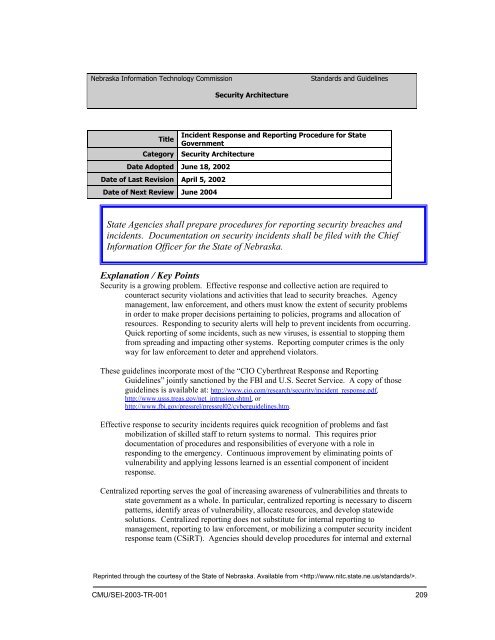State of the Practice of Computer Security Incident Response Teams ...
State of the Practice of Computer Security Incident Response Teams ...
State of the Practice of Computer Security Incident Response Teams ...
Create successful ePaper yourself
Turn your PDF publications into a flip-book with our unique Google optimized e-Paper software.
Nebraska Information Technology Commission<br />
Standards and Guidelines<br />
<strong>Security</strong> Architecture<br />
Title<br />
Category<br />
<strong>Incident</strong> <strong>Response</strong> and Reporting Procedure for <strong>State</strong><br />
Government<br />
<strong>Security</strong> Architecture<br />
Date Adopted June 18, 2002<br />
Date <strong>of</strong> Last Revision April 5, 2002<br />
Date <strong>of</strong> Next Review June 2004<br />
<strong>State</strong> Agencies shall prepare procedures for reporting security breaches and<br />
incidents. Documentation on security incidents shall be filed with <strong>the</strong> Chief<br />
Information Officer for <strong>the</strong> <strong>State</strong> <strong>of</strong> Nebraska.<br />
Explanation / Key Points<br />
<strong>Security</strong> is a growing problem. Effective response and collective action are required to<br />
counteract security violations and activities that lead to security breaches. Agency<br />
management, law enforcement, and o<strong>the</strong>rs must know <strong>the</strong> extent <strong>of</strong> security problems<br />
in order to make proper decisions pertaining to policies, programs and allocation <strong>of</strong><br />
resources. Responding to security alerts will help to prevent incidents from occurring.<br />
Quick reporting <strong>of</strong> some incidents, such as new viruses, is essential to stopping <strong>the</strong>m<br />
from spreading and impacting o<strong>the</strong>r systems. Reporting computer crimes is <strong>the</strong> only<br />
way for law enforcement to deter and apprehend violators.<br />
These guidelines incorporate most <strong>of</strong> <strong>the</strong> “CIO Cyberthreat <strong>Response</strong> and Reporting<br />
Guidelines” jointly sanctioned by <strong>the</strong> FBI and U.S. Secret Service. A copy <strong>of</strong> those<br />
guidelines is available at: http://www.cio.com/research/security/incident_response.pdf,<br />
http://www.usss.treas.gov/net_intrusion.shtml, or<br />
http://www.fbi.gov/pressrel/pressrel02/cyberguidelines.htm.<br />
Effective response to security incidents requires quick recognition <strong>of</strong> problems and fast<br />
mobilization <strong>of</strong> skilled staff to return systems to normal. This requires prior<br />
documentation <strong>of</strong> procedures and responsibilities <strong>of</strong> everyone with a role in<br />
responding to <strong>the</strong> emergency. Continuous improvement by eliminating points <strong>of</strong><br />
vulnerability and applying lessons learned is an essential component <strong>of</strong> incident<br />
response.<br />
Centralized reporting serves <strong>the</strong> goal <strong>of</strong> increasing awareness <strong>of</strong> vulnerabilities and threats to<br />
state government as a whole. In particular, centralized reporting is necessary to discern<br />
patterns, identify areas <strong>of</strong> vulnerability, allocate resources, and develop statewide<br />
solutions. Centralized reporting does not substitute for internal reporting to<br />
management, reporting to law enforcement, or mobilizing a computer security incident<br />
response team (CSiRT). Agencies should develop procedures for internal and external
















